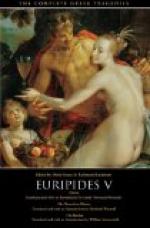P. 27, ll. 403, 409.]—Why does Electra send her husband to the Old Man? Not, I think, really for want of the food. It would have been easier to borrow (p. 12, l. 191) from the Chorus; and, besides, what the peasant says is no doubt true, that, if she liked, she could find “many a pleasant thing” in the house. I think she sends for the Old Man because he is the only person who would know Orestes (p. 21, l. 285). She is already, like the Leader (p. 26, l. 401), excited by hopes which she will not confess. This reading makes the next scene clearer also.
Pp. 28-30, ll. 432-487, O for the Ships of Troy.]—The two main Choric songs of this play are markedly what Aristotle calls [Greek: embolima] “things thrown in.” They have no effect upon the action, and form little more than musical “relief.” Not that they are positively irrelevant. Agamemnon is in our minds all through the play, and Agamemnon’s glory is of course enhanced by the mention of Troy and the praises of his subordinate king, Achilles.
Thetis, the Nereid, or sea-maiden, was won to wife by Peleus. (He wrestled with her on the seashore, and never loosed hold, though she turned into divers strange beings—a lion, and fire, and water, and sea-beasts.) She bore him Achilles, and then, unable permanently to live with a mortal, went back beneath the sea. When Achilles was about to sail to Troy, she and her sister Nereids brought him divine armour, and guided his ships across the Aegean. The designs on Achilles’ armour, as on Heracles’ shield, form a fairly common topic of poetry.
The descriptions of the designs are mostly clear. Perseus with the Gorgon’s head, guided by Hermes; the Sun on a winged chariot, and stars about him; two Sphinxes, holding as victims the men who had failed to answer the riddles which they sang; and, on the breastplate, the Chimaera attacking Bellerophon’s winged horse, Pegasus. The name Pegasus suggested to a Greek [Greek: pege], “fountain;” and the great spring of Pirene, near Corinth, was made by Pegasus stamping on the rock.
Pp. 30-47.]—The Old Man, like other old family servants in Euripides—the extreme case is in the Ion—is absolutely and even morbidly devoted to his masters. Delightful in this first scene, he becomes a little horrible in the next, where they plot the murders; not only ferocious himself, but, what seems worse, inclined to pet and enjoy the bloodthirstiness of his “little mistress.”
Pp. 30-33, ll. 510-545.]—The Signs of Orestes. This scene, I think, has been greatly misunderstood by critics. In Aeschylus’ Libation-Bearers, which deals with the same subject as the Electra, the scene is at Agamemnon’s tomb. Orestes lays his tress there in the prologue. Electra comes bringing libations, sees the hair, compares it with her own, finds that it is similar “wing for wing” ([Greek: homopteros]—the same word as here), and guesses that it belongs to Orestes. She then measures the footprints, and finds one that is like her own, one not; evidently Orestes and a fellow-traveller! Orestes enters and announces himself; she refuses to believe, until he shows her a “woven thing,” perhaps the robe which he is wearing, which she recognises as the work of her own hand.




